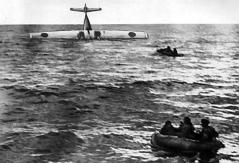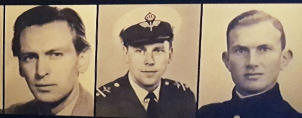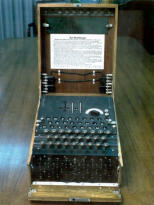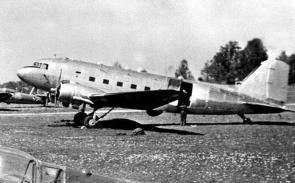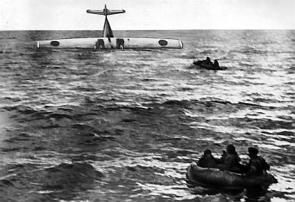

Copyright © Hans Högman 2021-01-19
Military Cryptography
Department 1939 - 1945
Swedish Signals Intelligence
Collection 1939 - 1945
Intelligence collection management is the process
of managing and organizing the collection of
intelligence from various sources.
Signals intelligence is intelligence-gathering by
interception of signals, whether communications
between people or from electronic signals not
directly used in communication. Signals intelligence is
a subset of intelligence collection management. As
sensitive information is often encrypted, signals
intelligence, in turn, involves the use of cryptanalysis
to decipher the messages.
Signals intelligence is a subset of intelligence
collection management.
Introduction
During WWII, Denmark and Norway were occupied by
German armed forces on 9 April 1940. The Germans
used the Swedish telephone network for their
telecommunication with its forces in Norway.
Germany hired telephone lines from Sweden.
The Swedish General Staff was willingly accepting
this, thereby Swedish intelligence was able to listen in
on the German communications. So, the Swedish
government accepted the German request to hire
telephone lines and the lines were subsequently
tapped by the Swedish Military Intelligence.
The Cryptography Department (Swe:
Kryptoavdelningen) with its Crypto Detail IV, was
responsible for cryptanalysis. They immediately
started to intercept German communication. The
Crypto Department was a predecessor to FRA
(Försvarets radioanstalt, English: National Defense
Radio Establishment).
However, it soon became clear that the traffic was
almost always encrypted by the German state-of-the-
art cipher machine Geheimfernschreiber. This device
was believed to produce indecipherable messages.
The instrument was known as the “G-skrivaren” by
Swedish cryptanalysts. The official name was
Siemens & Halske T52 and it was a World War II
German cipher machine and teleprinter produced
by the electrical engineering firm Siemens & Halske.
The Swedish Professor of mathematics Arne
Beurling with the Cryptography Detail IV,
Cryptography Department, was set to break the
encryption. After two weeks of single handwork in
the summer of 1940, he decoded the cipher of the G-
schreiber T52 with the only use of pencil and paper
with only one day’s collection of messages as the
source.
The standard of the telephone network wasn’t the
best and in part unstable during the war, which often
interrupted the German telegrams. Due to the very
large amount of messages and pressure of time, the
German machine operators often reused the
encryption keys, known as indicators. These mistakes
made it possible to break the code.
Using Professor Beurling's work, the telephone
company Ericsson manufactured several T52 analog
machines that could decode the messages once the
key settings had been found by hand.
The Swedish Military Intelligence was then able to
read traffic in the system for three years, not only
between Berlin and Oslo, but also between Germany
and the German forces in Finland, and of course to
the German embassy in Stockholm. In total, Sweden
intercepted 500,000 German messages and
decrypted 350,000.
In 1941, Sweden became the first nation, besides
Germany, to possess information about the
forthcoming German attack on the Soviet Union,
Operation Barbarossa. The Swedes passed this
information to the Allies through the UK. Not to
invoke any German suspicions that Sweden had
broken their code, the Swedish Government faked
that they went off to celebrate Midsummer Feast, the
day before the German’s planned attack at the USSR.
In the fall of 1941 and the winter of 1941/1942, there
were intelligence information that Germany prepared
for an attack on Sweden. In February 1941 the
situation was critical and this period is known as the
February Crisis. The Germans were then considerably
strengthening their forces in Norway for a possible
invasion of Sweden. This was known by the Swedish
General Staff since the Swedish military intelligence
was listening in on the German telecommunications.
The Swedish answer was a further mobilization and
carried out a gigantic military maneuver in Jämtland
by the Norwegian border with about 300,000 Swedish
soldiers.
At this point, Finland was collaborating with the
Germans and the Swedish Military Intelligence,
deceitfully informed the Finnish Envoy to Sweden
that Sweden would defend themselves even if the
Allies tried to invade Sweden, in the hope that the
Germans would pick up this information, which they
did.
Geheimfernschreiber, G-cipher
Siemens Halske T52 Geheimfernschreiber, in Sweden
known as the “G-skrivaren” or “G-maskinen” (G-
cipher/G-schreiber). The official name was Siemens
& Halske T52 and it was a World War II German
cipher machine and teleprinter produced by the
electrical engineering firm Siemens & Halske.
Siemens produced several and mostly incompatible
versions of the T52.
While the Enigma cipher machine was generally used
by field units, the T52 was an online machine used by
Luftwaffe and German Navy units, which could
support the heavy machine, teletypewriter, and
attendant fixed circuits. It fulfilled a similar role to the
Lorenz cipher machines in the German Army.
The German communication between Germany and
their forces in Norway and Finland, and the German
Embassy in Stockholm, were encrypted by the T52
cipher machine over the Swedish telephone network,
messages intercepted by the Swedish Crypto
Department.
The T52 was believed to produce indecipherable
messages, with its 893,622,318,929,520,960 different
crypto key settings. It had ten pinwheels, which were
stepped in a complex nonlinear way, based in later
models on their positions from various delays in the
past, but in such a way that they could never stall.
This produced a much more complex cipher than the
Lorenz machine.
The Germans thought that the T52 encrypted
messages were impossible to break.
An improvement in T52 security in 1942 was defeated
by the Swedes. However, the
second upgrade in mid-1943
was not, and the flow of
decrypted messages came to
an end.
The image to the right shows
the German G-cipher
machine, Siemens
Geheimfernschreiber, T-Type
52D. Image: Wikipedia.
This machine's cipher is generally considered to be
more complicated than that of more famous Enigma
machine.
The Germans became aware of the Swedish
decrypting
In June 1942, the Germans became aware that the
Swedes were able to decrypt their coded messages
sent with the T52 G-Schreiber. Late on 17 June 1942,
an alarming German coded message was decrypted
which read ”These messages are decrypted in Sweden”.
Shortly thereafter, all German messages became
unreadable. An improvement in the T52 security had
been made, however also this was defeated by the
Swedes. However, the second upgrade in mid-1943
was not, and the flow of decrypted messages came to
an end.
It is still unknown how the Germans became aware of
the Swedish decryption of their T52 coded messages.
However, there are strong shreds of evidence that
one of the Swedish contacts with the Finns gave
himself away and that the Finns passed on the
information to the Germans.
Since 1941, Finland was allied with Germany.
However, despite this, the Swedish contacts with the
Finnish intelligence continued. A theory is that a high
ranked Finnish officer on a visit to the Swedish
military intelligence HQ in Stockholm saw a
decrypted German message on a writing desk in a
room where he for a moment been left alone. He
immediately understood that the Swedes were able
to decrypt the T52 coded messages and forwarded
this to the Germans.
In April 1943, a few of Beurling’s successors managed
to break coded messages produced by the German Z-
chiper machine. However, when a new version of the
G-chiper (Dora) was launched, Sweden failed to break
its coded messages. But, Sweden was able to decrypt
Dora coded messages from 1944. Then, a German
defector handed over an operational Dora machine
to the Swedish Military Intelligence.
Professor of Mathematics Arne Beurling
Arne Karl-August Beurling was born on 3 February
1905 in Göteborg and died on 20 November 1986 in
Princeton, New Jersey, USA. He was a Swedish
Professor of Mathematics at Uppsala University and
later at the Institute for Advanced Study in Princeton,
New Jersey. Professor Beurling is perhaps most
famous for single-handedly deciphering an early
version of the German cipher machine Siemens and
Halske T52 in a matter of two weeks during 1940,
using only pen and paper.
After graduating in 1924, he was enrolled at the
Uppsala University where he received a Bachelor of
Arts degree in 1926 and two years later a Licentiate
of Philosophy degree.
Beurling was an assistant teacher at Uppsala
University from 1931 to 1933. He received his
doctorate in mathematics in 1933
for his dissertation Études sur un
problème de majoration. Beurling
was a docent of mathematics at
Uppsala University from 1933 and
then professor of mathematics
from 1937 to 1954.
The image to the right shows
Professor Arne Beurling.
At the outbreak of WWII in 1939, he contacted
Captain Eskil Gester with the Military Intelligence’s
Cryptography Department and offered his services.
Beurling was immediately hired and was given a
position with signals collecting at a secret address
near Karlaplan in Stockholm. The department was
occupied with intercepting and decrypting coded
Soviet radio traffic.
The department managed to break the Soviet coded
messages just before the Soviet invasion of Finland in
November 1939 (The Winter War). Thereby, Sweden
was able to provide the Finns with valuable
information throughout the Winter War.
The German G-Schreiber was a much more complex
machine, however, Beurling managed to decode the
cipher of the G-schreiber in a matter of two weeks
during 1940. His achievement was quite possibly the
finest feat of cryptanalysis performed during the
Second World War.
However, his success combined with a hot temper
created continual conflicts within the Cryptography
Department and Beurling was dismissed in the spring
of 1942. Then, he returned to his position with
Uppsala University.
Cryptography Department
becomes FRA
Sweden has been pursuing signals intelligence
(SIGINT) since 1905. Then, both the Swedish General
Staff and Naval Staff respectively had departments
for signals intelligence and cryptanalysis. These
departments were, during WWI, able to break the
Russian Baltic Sea Navy’s encrypted traffic. A major
success occurred in 1933 when the cipher of the
Russian OGPU (predecessor to KGB) was solved.
On 1 July 1937, the Swedish Defense Staff (Swe:
Försvarsstaben) was established. The Cryptography
Department, with its Crypto Detail IV, was initiated
at the outbreak of WWII in 1939 under the command
of Sven Hallenborg and was responsible for
cryptanalysis. Then, the department consisted of
about 50 cryptanalysts.
The first stationary signals collection site was located
at the Crypto Detail IVs premises near Karlaplan
Central Stockholm, but in 1940 it was moved to
several villas at Elfviks Udde in the suburban island of
Lidingö. More sites were established in other places
in Sweden too.
The National Defense Radio Establishment (Swe:
Försvarets Radioanstalt, FRA) was gradually
established. In 1938, there was a department
responsible for signal intelligence collecting for all the
armed services and was located at the Karlskrona
Naval Station in Blekinge. A few years later they were
merged with the intelligence collection carried out by
the Defense Staff’s Cryptography Department in
Stockholm.
On 1 July 1942, an independent government agency
was organized under the Swedish Ministry of Defense
named Försvarsväsendets radioanstalt (FRA). It was
then headed by the naval officer Torgil Thorén
(1892-1982) who in charge of the agency between
1942 - 1957.
In October 1943, FRA moved its headquarters to a
secret location in Lovön, some 15 km from
Stockholm. In 1962, the agency’s name was changed
to Försvarets Radioanstalt (FRA), in English; The
National Defense Radio Establishment.
Operation Stella Polaris
In the final stage of the Finnish-Soviet Continuation
War in1943 – 1944, the Soviet Union threatened to
occupy Finland. Then, the Finnish intelligence
requested to transfer about 200 specialists and
advanced intelligence equipment to Sweden to
establish an exile organization. A transfer of a minor
contingent of personnel and materials, Operation
Stella Polaris, was carried out over a couple of nights
in September 1944.
Stella Polaris gave Sweden access to qualified
materials and signals intelligence officers, some of
which were also employed. For Finland, it resulted in
a domestic political affair and due to the Communist
Party's strong influence in the government, several of
the so-called "Soviet Hostiles" involved received
prison sentences.


The Shooting Down of a Swedish Spy Aircraft
in 1952
On 13 June 1952, a Soviet fighter aircraft (MIG-15), in
international airspace over the Baltic Sea, shot down
a Swedish Air Force DC-3. The Swedish aircraft was
a spy plane carrying out signals intelligence
reconnaissance against the USSR, designated Tp 79
Hugin (TP 79001). The Swedish aircraft had a crew of
eight, three crew members from the Air Force and
five from the FRA.
The Air Force pilot was Alvar Älmeberg and the FRA
intelligence agents were under the command of Einar
Jonsson. At each of the five signals collecting and
analysis stations aboard the aircraft were advanced
equipment fitted. These flights were the object of top
secrecy.
It was believed that all members of the crew died
when the aircraft crashed into the Baltic Sea. The
aircraft was salvaged from the bottom of the sea in
2003. Then, the mortal remains of four crew
members were found.
The upper
images to the
right show the Air
Force crew on the
flight on 13 June
1952, from left:
Flight Mechanic Herbert Mattsson, signalist and
navigator Gösta Blad, and pilot Alvar Älmeberg.
Photo: Hans Högman 2017, Air Force Museum in
Linköping.
The lower images show the FRA signals intelligence
agents on the flight on 13 June 1952, from left:
Börge Nilsson, Erik Carlsson (Russian-speaking), Ivar
Svensson, Bengt Book, and Einar Jonsson (head of
the section).
Photo: Hans Högman 2017, Air Force Museum in
Linköping.
The DC-3 took off from Bromma Airport, Stockholm,
on the morning of 13 June 1952 for a signals
intelligence reconnaissance mission. At 11:08, the
navigator Gösta Blad reported the aircraft’s position
for the last time. At 11:23, the F 2 Roslagen Air Wing
in Hägernäs, Sweden, received a distress signal from
the DC-3 which was soon discontinued. This was the
last contact with the aircraft.
The aircraft was flying east of the Swedish island of
Gotland in the Baltic Sea but west of the Soviet
Union. However, the exact location of the crash was
at the time unknown. Initially, the Swedish
government claimed that the flight was only a
navigational exercise, but later admitted that the
aircraft had U.S. electronic surveillance equipment
and five signals intelligence specialists from FRA
aboard.
The Soviet Union denied any involvement in the
disappearance of the DC-3, even though a raft from
the Swedish DC-3 was found during the search with
shrapnel from MiG-15 ammunition.
The image to the right
shows the DC-3 spy
aircraft (Tp 79 Hugin
with Air Force serial
number 79001) at the F
8 Svea Air Wing in
Barkarby, Stockholm, in
1951, i.e. a year before it was shot down. A twin
aircraft was called Munin (79002). Image: Wikipedia.
On 16 June 1952, three days later, a Swedish Air
Force search-and-rescue aircraft Tp 47 Catalina
(47002) was shot down by a Soviet MiG-15 fighter,
but the pilot managed to make a forced landing at
the sea. Then, the five crew members were rescued
by a nearby West German freighter ship, Münsterland.
The Soviets shooting down of an unarmed sea-rescue
aircraft during a rescue mission over international
airspace caused a diplomatic crisis, the Catalina
Affair (Swe: Catalinaaffären).
The image to the right
shows the sinking
Catalina Tp 47 after the
aircraft was shot down
by a Soviet fighter in
1952. The photo was
taken from the German
freighter ship
Münsterland. Image: Wikipedia.
In 1956, the Soviet leader Nikita Khrushchev
admitted to Swedish Prime Minister Tage Erlander
that the Soviet Union was indeed responsible for
shooting down the DC-3, but this was not made
public, not even to the relatives of the crewmen.
Russia officially acknowledged the shooting down in
1991.
On 10 June 2003, the wreck of the shot-down DC-3
Tp 79 was found about 55 km (34 mi) east of Gotland
on international waters at a depth of 125 m (410 ft).
Four of the crew member's mortal remains were
found in the fuselage and the damage to the aircraft
showed that it had been shot at by a Soviet MiG-15
fighter.
The wrecked aircraft was salvaged on 18 - 19 March
2004. The mortal remains of the four crew members
have been identified: they were Alvar Älmeberg,
Gösta Blad, Herbert Mattson, and Einar Jonsson, and
they were buried on 5 July 2006 in the Memorial Park
at the Galley Yard Cemetery, Stockholm
(Galärvarvskyrkogården).
On 13 June 2004, the crew members were
posthumously awarded the Swedish Armed Forces
Medal of Merit (Swe: Försvarsmaktens
förtjänstmedalj) in gold. This is a military reward
medal and is awarded to individuals for action during
combat or during war-like situations at a ceremony at
the Berga Naval Base.
Enigma Machine
The Enigma machine is an encryption device
developed and used in the early- to mid-20th century
to protect commercial, diplomatic, and military
communication. The Enigma machine was invented
by the German engineer Arthur Scherbius at the end
of World War I. Enigma has an electromechanical
rotor mechanism that scrambles the 26 letters of the
alphabet.
It was employed extensively by Nazi Germany during
World War II, in all branches of the German military.
The name Enigma became widely known in military
circles and it is the German version, Wehrmacht
Enigma, which people usually have in mind when they
refer to Enigma.
Several different Enigma models were produced, but
the German military models, having a plugboard,
were the most complex.
Unlike the G-schreiber, Enigma was compact and
easily portable.
While Germany introduced a series of improvements
to Enigma over the years and these hampered
decryption efforts to varying degrees, they did not
ultimately prevent Britain and its allies from
exploiting Enigma-encoded messages as a major
source of intelligence during the war.
Many commentators say the flow of Ultra
communications intelligence from the decryption of
Enigma, Lorenz, and other ciphers shortened the war
significantly, and may even have altered its outcome.
Though Enigma had some cryptographic weaknesses,
in practice it was German procedural flaws, operator
mistakes, failure to systematically introduce changes
in encipherment procedures, and Allied capture of
key tables and hardware that, during the war,
enabled Allied cryptologists to succeed and "turned
the tide" in the Allies' favor. During the war, British
cryptologists decrypted a vast number of messages
enciphered on Enigma. The intelligence gleaned from
this source, codenamed "Ultra" by the British, was a
substantial aid to the Allied war effort.
Alan Turing was the central force in continuing to
solve the Enigma code in the United Kingdom, during
World War II. Alan Mathison Turing (1912 - 1954) was
an English mathematician, computer scientist,
logician, cryptanalyst, and theoretical biologist.
During WWII, Turing worked for the Government
Code and Cypher School (GC&CS) at Bletchley Park,
Britain's codebreaking center that produced Ultra
intelligence.
Two Enigma machines were
acquired after the capture of
German submarine U-505 during
World War II.
The image to the right shows a
German Wehrmacht Enigma
machine. Image: Wikipedia.
The German G-Schreiber, which
Swedish Professor Beurling managed to break, was a
much more complex machine than Enigma.
Bletchley Park
Bletchley Park is an English country house and
estate in Milton Keynes (Buckinghamshire) that
became the principal center of British code-
breaking during WWII. It is about 70 km north-west
of London.
During the war, the estate housed the Government
Code and Cypher School (GC&CS), which regularly
penetrated the secret communications of the Axis
Powers – most importantly the German Enigma and
Lorenz ciphers. The nature of the work there was a
secret until many years after the war.
It is believed that the "Ultra" intelligence produced at
Bletchley shortened
the war by two to
four years.
The image to the
right shows
Bletchley Park.
Image: Wikipedia.
Bletchley Park was known as "B.P." to those who
worked there. "Station X", "London Signals
Intelligence Centre", and "Government
Communications Headquarters" were all cover
names used during the war.
The first personnel (about 180) of the Government
Code and Cypher School (GC&CS) moved to Bletchley
Park on 15 August 1939. Among its most notable
early personnel, the GC&CS team of codebreakers
included Alan Turing, Gordon Welchman, Hugh
Alexander, Bill Tutte, and Stuart Milner-Barry. In
January 1945, at the peak of codebreaking efforts,
nearly 10,000 personnel were working at Bletchley
and its outstations. About three-quarters of these
were women. The staff worked a six-day week,
rotating through three shifts.
Most German messages decrypted at Bletchley were
produced by one or another version of the Enigma
cipher machine, but an important minority were
produced by the even more complicated twelve-rotor
Lorenz SZ42 on-line teleprinter cipher machine. At its
peak, GC&CS was reading approximately 4,000
messages per day.
The bombe was an electromechanical device whose
function was to discover some of the daily settings of
the Enigma machines on the various German military
networks. Its pioneering design was developed by
Alan Turing.
The Lorenz messages were codenamed Tunny at
Bletchley Park.
A piece of automatic machinery to help with
decryption was devised, which culminated in
Colossus, the world's first programmable digital
electronic computer. The prototype first worked in
December 1943, was delivered to Bletchley Park in
January and first worked operationally on 5 February
1944.

